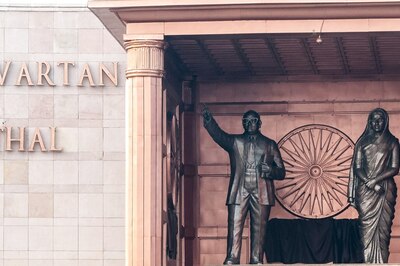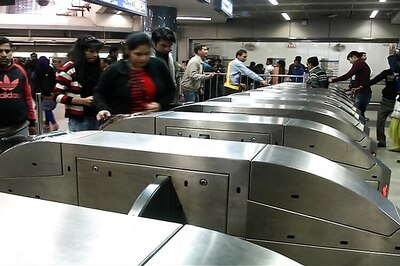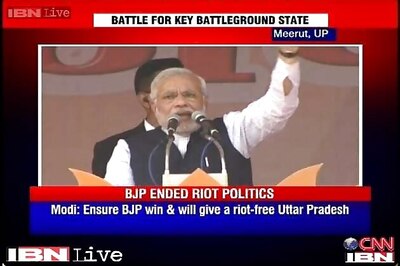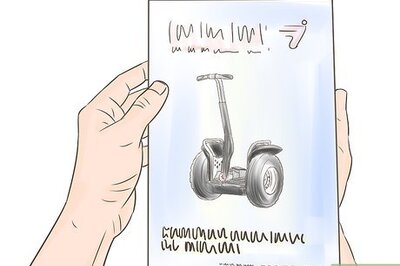5-Day-Long Cold Wave, Dense Fog Keep North India Shivering; Around 70 Flights Delayed in Delhi Again

views
The five-day-long cold wave has left north and northwest India shivering under a cold spell even as dense fog adversely affected air, rail and road traffic and even led to two road accidents in Uttar Pradesh killing seven people.
Delhi’s Safdarjung recorded a minimum temperature of 6.4°C while Palam recorded a minimum temperature of 7.5°C till 8.30am. Visibility in Palam area recorded at 50 metres and Safdarjung at 200 metres. Due to bad weather, the departure of around 50 domestic flights were delayed at Delhi airport. Eighteen arrival flights (domestic) were also delayed.
Delhi saw cold wave conditions for the fifth consecutive day on Monday as very dense fog reduced visibility to just 25 metres, officials said. On Tuesday, several areas in Uttar Pradesh and Delhi reported sub 50 metres visibility due to thick fog cover. As severe cold wave and dense fog continued unabated, India Meteorological Department (IMD) issued a a red and yellow alert in several parts of the country.
Dense/Very Dense Fog layer (in white patch) extends from Punjab to Bihar across Haryana, Delhi and Uttar Pradesh at 0530 hours IST of 10.01.2023. pic.twitter.com/2jE2xB8lKj— India Meteorological Department (@Indiametdept) January 10, 2023
The cold wave spell in Delhi has been so intense that the national capital has recorded a minimum temperature lower than that of most places in Himachal Pradesh and Uttarakhand for five days on the trot.
Meteorologists attribute the long spell of intense cold to a large gap between two western disturbances, which meant frosty winds from the snow-clad mountains blew in for a longer-than-usual period.
The visibility levels dropped to 50 metres at the Palam observatory, near the IGI Airport, and 25 metres at the Safdarjung observatory and the Ridge weather station, an official of the India Meteorological Department (IMD) said.
Trains and Flights Delayed
So far on Tuesday, 36 trains are running late Northern Railway region due to fog.
36 trains running late in the Northern Railway region due to fog. pic.twitter.com/qHyZuXkQZW— ANI (@ANI) January 10, 2023
A total of 267 trains were delayed due to bad weather, a railway official said. Five flights were diverted and 30 delayed due to the foggy conditions, officials at the Indira Gandhi International Airport said.
Rajasthan Under Fog Blanket
In Rajasthan, a dense layer of fog enveloped some parts of the state as cold wave conditions prevailed in the state. A MeT department spokesperson said there was no major change in minimum temperatures, even though a slight rise in mercury was witnessed in Jaipur and Bikaner divisions. On Sunday night, Karauli and Fatehpur were recorded as the coldest, with the minimum temperatures at 3.2 and 3.5 degrees Celsius, respectively.
Cold Wave Grips Odisha
Cold wave conditions gripped Odisha also with the mercury dipping to as low as 3.7 degrees Celsius in Similiguda in Koraput district, the weather office said.While Sundergarh was shivering at 4.3 degrees Celsius, Phulbani recorded 4.9 degrees and Jharsuguda 7.8 degrees.
Rainfall in J&K Provides Respite From Cold Wave
In Jammu and Kashmir, snowfall in higher reaches and light drizzle in plains extended the respite from cold wave conditions in Kashmir as minimum temperatures stayed around freezing point in most parts of the valley.
There was light to moderate snowfall in hilly areas like Gulmarg, Sonamarg-Zojila axis and Machhil in Kupwara, officials said. They said a light drizzle took place over night in many plain areas of the valley.
UP’s Etawah Records 3 Degree Celsius
A dense fog enveloped parts of Uttar Pradesh on Monday morning with Etawah recording the lowest minimum temperature at 3 degrees Celsius, according to the Meteorological Centre.
Light Rains Likely In Some Areas
Light rain or drizzle may occur in some places in the western areas of the state for the next two-three days.
Road Accidents Kill People
In the state, seven people, including three Nepalese citizens, died in separate road accidents on the Agra-Lucknow Expressway amid dense fog, police said.
In the first incident, a Nepal-bound bus carrying 60 passengers rammed into a truck on the expressway in Unnao on Monday, leaving the driver and three Nepalese citizens dead, officials said. Six other passengers, four of them also from Nepal, got injured in the incident and have been hospitalised, they said.
Additional Superintendent of Police Shashi Shekhar Singh said the bus was going from Rajkot in Gujarat to Nepal. The accident occurred in the Auras area of Unnao.
In the other incident, three passengers were killed, while 18 others injured as a Sultanpur-bound bus fell off the expressway in Piprauli village.
The bus carrying 30 passengers was coming from Anand Vihar in Delhi, police said, adding four of the passengers were seriously injured in the accident that took place on Sunday night. Satellite images showed a fog layer extending from Punjab and adjoining northwest Rajasthan to Bihar through Haryana, Delhi and Uttar Pradesh.
Delhi Weather Stats
The minimum temperatures in the national capital rose marginally though. The Safdarjung observatory, Delhi’s primary weather station, recorded a minimum of 3.8 degrees Celsius as against 1.9 degrees on Sunday, which was the second lowest in the month since 2013.
The weather stations at Lodhi Road, Ayanagar and Ridge recorded a minimum temperature of 3.6 degrees, 3.2 degrees and 3.3 degrees.
It (Monday) was the fifth consecutive day that Delhi’s minimum temperature was lower than most hill stations in Himachal Pradesh and Uttarakhand, including Dalhousie (9 degrees), Dharamshala (9.2 degrees), Shimla (10.3 degrees), Manali (6 degrees), Dehradun (6.5 degrees), Mussoorie (11.3 degrees), and Nainital (6 degrees), according to the IMD.
The chilly weather has prompted the Delhi government to extend winter vacation in schools till January 15.
“The long cold wave spell in Delhi can be attributed to a large gap between two western disturbances which allowed the chilly northwesterly winds from the mountains to affect the plains for a longer-than-usual period,” Mahesh Palawat, vice president (meteorology and climate change), Skymet Weather, said.
Usually, there is a gap of three to four days between two western disturbances. This time, the gap increased to seven days, Palawat said. A senior IMD official said short-term relief is likely after a couple of days under the influence of back-to-back western disturbances.
When a Western disturbance — a weather system characterised by warm moist winds from the Middle East — approaches a region, the wind direction changes. Hence, the chilly northwesterly winds from the mountains will stop blowing for a few days leading to an increase in temperatures, he said.
The IMD said the foggy weather may reduce visibility on highways and advised people to drive slowly and use fog lights.
There are chances of tripping of power lines in areas witnessing very dense fog, it said, adding long exposure to dense fog may cause respiratory problems for people having asthma and other lung-related problems.




















Comments
0 comment